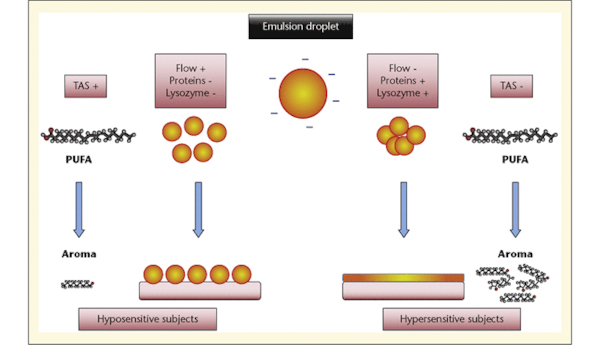Figure 2.

Download original image
Schematic representation of the causal hypothesis formulated from the different correlations observed between fat multimodal sensitivity and saliva composition (Poette et al., 2012). In this hypothesis, saliva can act on two characteristics, i.e., texture and olfaction. In hypersensitive subjects, low salivary flow and a high amount of proteins and lysozyme can contribute to a higher retention and destabilisation of the emulsion at the surface of the tongue, enhancing the perception of fat texture. Additionally, low TAS can be interpreted as a higher sensitivity of these subjects to volatile compounds resulting from the oxidation of unsaturated fatty acids. Oxidation can occur either in the emulsion or in the oral cavity during fat consumption. Conversely, in hyposensitive subjects, a high flow and low level of protein and lysozyme can contribute to a fast oral clearance of the emulsion just after consumption. Moreover, high TAS may lead to a low sensitivity of these subjects to volatile compounds resulting from the oxidation of unsaturated fatty acids. PUFA = polyunsaturated fatty acid, TAS = total antioxidant status
Les statistiques affichées correspondent au cumul d'une part des vues des résumés de l'article et d'autre part des vues et téléchargements de l'article plein-texte (PDF, Full-HTML, ePub... selon les formats disponibles) sur la platefome Vision4Press.
Les statistiques sont disponibles avec un délai de 48 à 96 heures et sont mises à jour quotidiennement en semaine.
Le chargement des statistiques peut être long.




